
geek
We haven’t told anybody before, but Windows has a hidden “How-To Geek Mode” that you can enable which gives you access to every Control Panel tool on a single page—and we’ve documented the secret method for you here.
我們以前沒有告訴過任何人,但是Windows具有隱藏的“操作方法”,您可以啟用它,使您可以在單個頁面上訪問每個控制面板工具-并且我們在此為您介紹了秘密方法。
Update: Do not use this on Vista. If you did, you can use Ctrl+Shift+Esc to start task manager, File \ Run and open a command prompt with cmd.exe, and then use the rmdir command to get rid of the folder.
更新:不要在Vista上使用它。 如果這樣做,則可以使用Ctrl + Shift + Esc啟動任務管理器,依次執行File \ Run和cmd.exe,然后使用rmdir命令刪除該文件夾。
To activate the secret How-To Geek mode, right-click on the desktop, choose New –> Folder, and then give it this name:
要激活秘密的How-To Geek模式,請在桌面上單擊鼠標右鍵,選擇“新建”->“文件夾”,然后為其指定名稱:
How-To Geek.{ED7BA470-8E54-465E-825C-99712043E01C}
入門指南。{ED7BA470-8E54-465E-825C-99712043E01C}
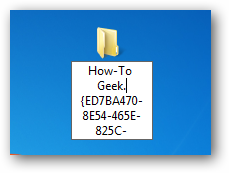
Once you’ve done so, you’ll have activated the secret mode, and the icon will change…
完成此操作后,您將激活秘密模式,并且圖標將更改……
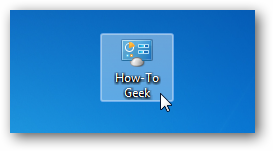
Double-click on the icon, and now you can use the How-To Geek mode, which lists out every single Control Panel tool on a single page.
雙擊該圖標,現在可以使用How-To Geek模式,該模式在單個頁面上列出了每個“控制面板”工具。
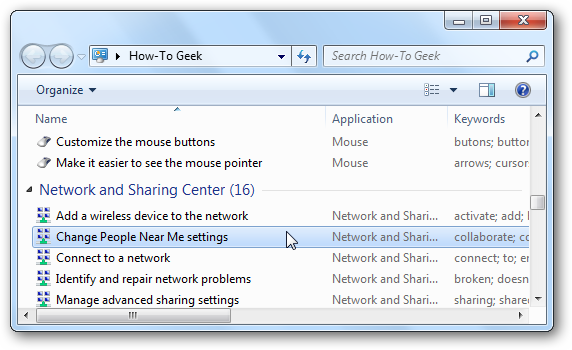
At this point you might notice why this is a stupid geek trick—it’s much easier to use the default Control Panel than navigating through a massive list, and anybody that really calls themselves a geek will be using the Start Menu or Control Panel search box anyway.
在這一點上,您可能會注意到為什么這是一個愚蠢的怪胎技巧-使用默認控制面板比瀏覽大量列表要容易得多,任何真正自稱為怪胎的人都將使用“開始菜單”或“控制面板”搜索框。
In case you were wondering, this is the same as that silly “God Mode” trick that everybody else is writing about. For more on why it’s pointless, see Ed Bott’s post on the subject.
如果您想知道,這與其他人正在寫的那個愚蠢的“上帝模式”技巧相同。 有關為什么它毫無意義的更多信息,請參閱Ed Bott在該主題上的文章。
Alright, So It’s Not Really a Secret How-To Geek Mode
好了,所以這并不是真正的秘密“極客模式”
Sadly, this is nothing more than a stupid geek trick using a technique that isn’t widely known—Windows uses GUIDs (Globally Unique Identifiers) behind the scenes for every single object, component, etc. And when you create a new folder with an extension that is a GUID recognized by Windows, it’s going to launch whatever is listed in the registry for that GUID.
令人遺憾的是,這僅是使用一種尚不為人所知的愚蠢技巧,Windows會在幕后為每個對象,組件等使用GUID(全局唯一標識符)。當您使用Windows可以識別的GUID擴展名,它將啟動該GUID注冊表中列出的所有內容。
You can see for yourself by heading into regedit.exe and searching for {ED7BA470-8E54-465E-825C-99712043E01C} under the HKCR \ CLSID section. You’ll see on the right-hand pane that it’s the “All Tasks” view of the Control Panel, which you can’t normally see from the UI.
您可以通過進入regedit.exe并在HKCR \ CLSID部分下搜索{ED7BA470-8E54-465E-825C-99712043E01C}來自己查看。 您會在右側窗格中看到“控制面板”的“所有任務”視圖,通常您無法從用戶界面中看到該視圖。
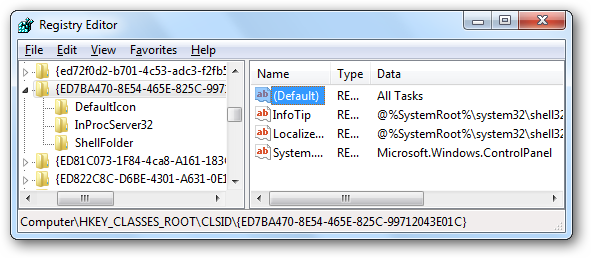
You can use this same technique for other Windows objects by doing some digging around in the registry… for instance, if you were to search under HKCR \ CLSID for “Recycle Bin”, you’d eventually come across the right key—the one on the left-hand side here:
您可以通過在注冊表中進行一些挖掘來對其他Windows對象使用相同的技術…例如,如果您要在HKCR \ CLSID下搜索“回收站”,您最終會遇到正確的鍵-一個這里的左側:
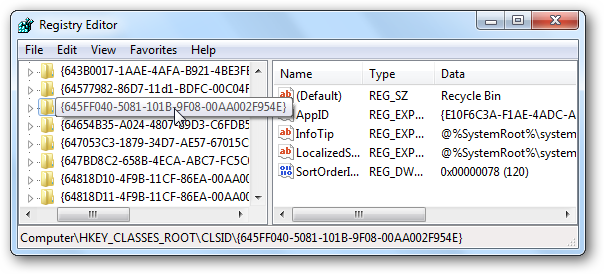
So if you created a folder with the name “The Geek Knows Deleted Files.{645FF040-5081-101B-9F08-00AA002F954E}”, you’d end up with this icon, clearly from the Recycle Bin.
因此,如果您創建了一個名為“ The Geek Knows Deleted Files。{645FF040-5081-101B-9F08-00AA002F954E}”的文件夾,則最終將得到該圖標,顯然來自回收站。
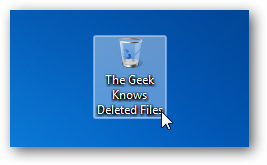
And it’s even a fully functional Recycle Bin… just right-click and you’ll see the menu:
而且它甚至是功能齊全的回收站……只需右鍵單擊,您將看到菜單:
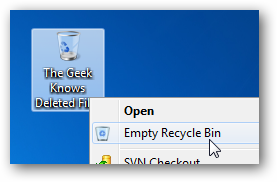
So here’s the quick list of the ones I felt like digging up, but I’m sure there’s more things you can launch if you really felt like it.
因此,這是我想要挖掘的內容的快速列表,但是我敢肯定,如果您真的喜歡的話,可以啟動更多的功能。
Recycle Bin: {645FF040-5081-101B-9F08-00AA002F954E}
回收站: {645FF040-5081-101B-9F08-00AA002F954E}
My Computer: {20D04FE0-3AEA-1069-A2D8-08002B30309D}
我的電腦: {20D04FE0-3AEA-1069-A2D8-08002B30309D}
Network Connections: {7007ACC7-3202-11D1-AAD2-00805FC1270E}
網絡連接: {7007ACC7-3202-11D1-AAD2-00805FC1270E}
User Accounts: {60632754-c523-4b62-b45c-4172da012619}
用戶帳戶: {60632754-c523-4b62-b45c-4172da012619}
Libraries:? {031E4825-7B94-4dc3-B131-E946B44C8DD5}
庫: {031E4825-7B94-4dc3-B131-E946B44C8DD5}
To use any of them, simply create a new folder with the syntax AnyTextHere.{GUID}
要使用其中任何一個,只需使用語法AnyTextHere創建一個新文件夾。{GUID}
Create Shortcuts to GUIDs
創建GUID的快捷方式
Since the GUID points to a Windows object launched by Windows Explorer, you can also create shortcuts and launch them directly from explorer.exe instead of creating the folder. For instance, if you wanted to create a shortcut to My Computer, you could paste in the following as the location for a new shortcut:
由于GUID指向Windows資源管理器啟動的Windows對象,因此您也可以創建快捷方式并直接從explorer.exe啟動它們,而不用創建文件夾。 例如,如果要創建“我的電腦”的快捷方式,則可以將以下內容粘貼為新快捷方式的位置:
explorer ::{20D04FE0-3AEA-1069-A2D8-08002B30309D}
資源管理器:: {20D04FE0-3AEA-1069-A2D8-08002B30309D}
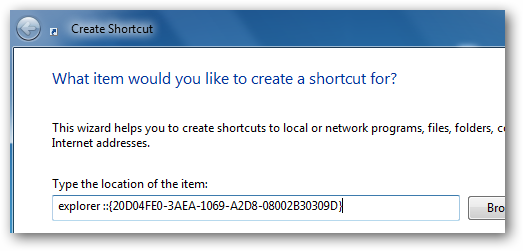
And just like that, you’d have a shortcut to My Computer, which you can customize with a different icon, and a shortcut key if you so choose.
就像那樣,您將擁有“我的電腦”的快捷方式,可以使用其他圖標來自定義該快捷方式,如果愿意,還可以使用快捷鍵。
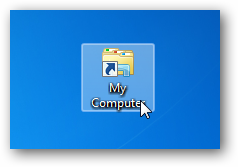
Yeah, it’s a stupid geek trick, but it’s always fun to learn new things.
是的,這是一個愚蠢的怪胎技巧,但是學習新事物總是很有趣。
Note: The Control Panel’s All Items hack and the Libraries hack will probably only work in Windows 7. The others should work in any version of Windows.
注意:“控制面板”的“所有項目”黑客和“庫”黑客可能僅在Windows 7中有效。其他應在任何版本的Windows中有效。
翻譯自: https://www.howtogeek.com/howto/8711/stupid-geek-tricks-enable-the-secret-how-to-geek-mode-in-windows/
geek

c++版)



)

(服務器/桌面))
)










